Back in the eighties, my corporate boyfriend, now my husband, prompted me to write a purpose and vision statement to define my fledgling decorative art company. My favorite line? “I do this work to keep open a channel for prayer.” This remains a reliable guide.
I know now that both fear and anger close that channel down. Weariness diminishes openness in a more subtle way. Breaking through these old patterns is part of building a business. Decorative artists must ride the wave of malleable conditions, conditions that cannot be predicted or controlled.
What can be controlled? And if it can, should it? Looking back, I would slow down. Just slow down. Observe. A cup of tea. The array of samples in the studio. This hand painted cup holding my tea. One small silver pitcher, the perfect size for a single sprig of daphne, a gift from an early mentor, Richard, before he died in the AIDS epidemic. When I slow down, inch by inch I come into the moment, and the kaleidoscope of all that shimmers within the now. That burden of weariness, usually the harbinger of anger and fear, shifts and lifts. I sip the tea. I remember to care for myself. I surrender. And then I am open. And receive. The story of the Blue Floor shows how that works.
discussing how to achieve the impossible!
One day about ten years ago James called me from Hawaii. He was there with his team for a couple of weeks, gilding and patterning a modern house on the big island. That work was going fine, but a project he would start when he returned was causing him sleepless nights. An inspired decorator envisioned the creation of a Cy Twombly painting, broad swishes of white with rows of random, variable drips cascading across a deep, painterly, rich indigo background. All this on a traditional oak floor of an expansive living room. And also: the compressed timeline; a zillion trades in the same building working feverishly; and finally, a finish able to withstand hundreds and hundreds of patrons touring the San Francisco Decorator Showcase. One more thing, the paint must be easily sanded away if the owner decided to return the floor to oak after the showcase.
There was a lot to worry about. James’ main question was how to be loose enough–and prepared enough– to paint the bold, swishing motions successfully, on the first try. Mistakes could not be removed. Terror!
I listened to his voice but in my mind saw a beach, a sandy Big Island beach, in morning light, waiting, undisturbed.
“James, does your rental condo there have an angled broom in the kitchen?”
“Yeah, I think so, why?”
“Take the broom to the beach and have the team, and yourself, do some swishes in the sand, practice the idea and see what feels right in scale and movement. The tide will create a fresh surface and you can try it again and again, ‘til you get the feel.”
making the swish believable, in advance!
That was just one of the many concerns that had to be solved for this project. The rich, powerful ground, a mix of blue and black tempera, was loosely brushed over the sanded and primed oak floor, emulating the background of a painting. This fragile surface was then protected with a thin coat of shellac. To guide the swishing process a bright string was laid on the shiny floor, repositioned until the designer liked the pattern. Creating the signature Twombly drips was another team effort. In the studio we practiced. We all had brilliant ideas, but with patience and skill only one artisan, using a plastic bottle with a small pointed nozzle, mastered the technique. Then clear varnish was applied over the entire floor.
Viewers were mystified, unable to believe the pattern was done flat. Crowds discussed how this effect could have been done—certainly it was done vertically in a studio? By breaking the original, inspired “impossible idea” into small bits, and using whatever was close at hand for inspiration, we succeeded in creating the decorator’s vision. Prayer, collaboration, wonder and letting go of fear, these are vital tools in every decorative artist’s toolbox.
The gleaming result was mystifying, the Blue Floor was a smashing success. It lives on in media posts and some magazine articles, but was sanded away a few weeks after the show was over.
Keep the faith, ride the wave, observe, care for yourself and your team. These are the elements within our control. And share your stories, we are in this together.
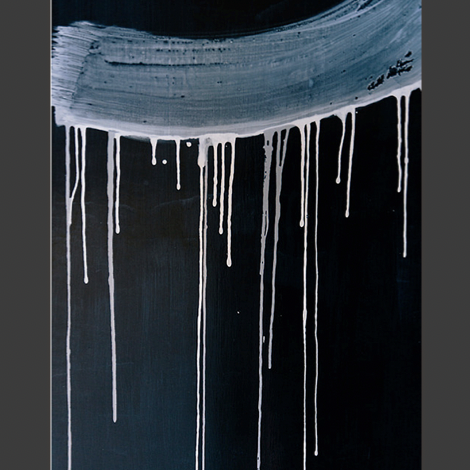
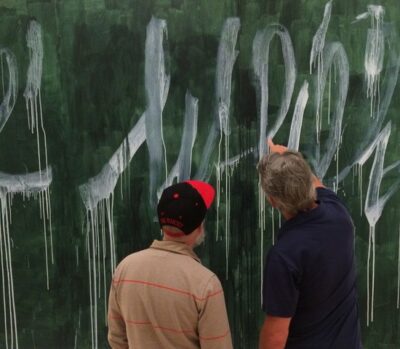
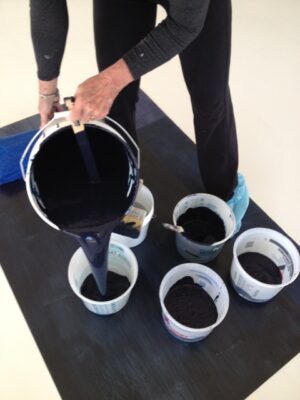
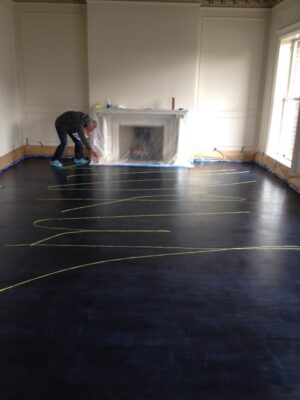
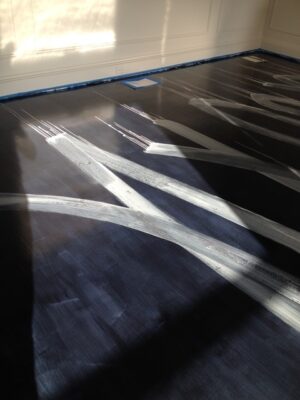
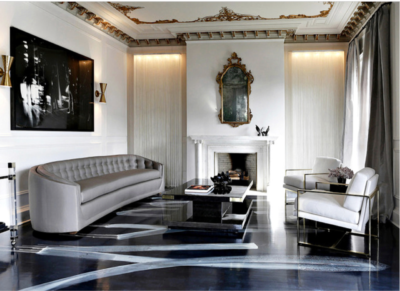
What a fun project. The practice maquette of the beach sand was the perfect exercise for the swooshy markings-good idea Elisa! Sometimes being removed from a problem lends clarity to solving it. Looking forward to your next book. LGC
Love the post…and the floor. Your ability to connect to prayer and contemplation are so inspiring, Elisa.
What a great project and stunning floor. You connected so many components- teamwork, faith, prayer, risk, patience and creativity. Such a good lesson that has carried you through. Wonderful that you learned to slow down and drink that tea in a cup given with love.
Inspirational! The ephemeral approach and transient floor. And all your musings over tea. Stunning.
I’ve always been amazed by this project, and I didn’t even know all these details and challenges that were faced when doing it! Thanks for sharing this snippet of that time, and the way that you all managed to get through it. The need for control is always overwhelming, and finding a way to break the situation down into feasible bits can seem impossible, but this story definitely proves otherwise!
Profoundly brilliant, Elisa, and stunningly gorgeous. Would never have conceptualized such an approach, nor have I seen the like previously. Thank you for sharing.